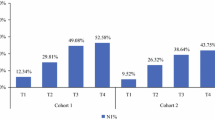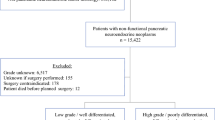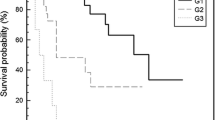Abstract
Background
Accurate grading of neuroendocrine neoplasms (NENs) is crucial for proper assessment of prognosis. Estimation of the proliferative indices, if not performed properly, is largely erroneous due to significant intratumoral heterogeneity. We sought to establish the degree of error in the grading of a cohort of curatively resected pancreatic NENs (PanNENs) and the theoretical impact of that in a larger cohort of Surveillance, Epidemiology, and End Results (SEER) patients.
Methods
A retrospective query of an institutional surgical database was performed from 2000 to 2018 to identify optimally resected PanNENs, which were reviewed by two gastrointestinal pathologists and regraded according to the WHO 2017 classification. Overall survival and recurrence-free survival were estimated using the Kaplan–Meier method for original and new grading systems, respectively and Cox proportional hazards models were used to evaluate the effect of the interested variables, including new grading systems.
Results
A total of 176 cases were identified. After regrading, 17/64 (26.6%) G1 neoplasms were classified as G2 and 12/95 (12.6%) G2 neoplasms were classified as G1, while 1/11 (9.1%) G3 neoplasms were classified as G2. Our expert gastrointestinal pathologists agreed on 97% of reclassified cases by blind review. Application of the G1/G2 misclassification errors on various groups, including PanNENs, in a SEER database of 1385 patients rendered the reported survival differences nonsignificant (1000 repetitions; p = 0.063, 95% confidence interval 0.056–0.070).
Conclusions
Mischaracterization of grade is common in optimally resected PanNENs but is eliminated with proper training and adherence to guidelines. The discrepancy rates can cast doubt on the generally accepted survival differences between G1 and G2 patients, as surmised by large database analyses.



Similar content being viewed by others
References
Merath K, Bagante F, Beal EW, et al. Nomogram predicting the risk of recurrence after curative-intent resection of primary non-metastatic gastrointestinal neuroendocrine tumors: an analysis of the U.S. Neuroendocrine Tumor Study Group. J Surg Oncol. 2018;117(5):868–78. Doi:10.1002/jso.24985.
Singhi AD, Klimstra DS. Well-differentiated pancreatic neuroendocrine tumours (PanNETs) and poorly differentiated pancreatic neuroendocrine carcinomas (PanNECs): concepts, issues and a practical diagnostic approach to high-grade (G3) cases. Histopathology. 2018;72(1):168–77. https://doi.org/10.1111/his.13408.
Yao JC, Hassan M, Phan A, et al. One hundred years after “carcinoid”: epidemiology of and prognostic factors for neuroendocrine tumors in 35,825 cases in the United States. J Clin Oncol. 2008;26(18):3063–72. https://doi.org/10.1200/jco.2007.15.4377.
Lauffer JM, Zhang T, Modlin IM. Review article: current status of gastrointestinal carcinoids. Aliment Pharmacol Ther. 1999;13(3):271–87.
Shah MH, Goldner WS, Halfdanarson TR, et al. NCCN Guidelines insights: neuroendocrine and adrenal tumors, version 2.2018. J Natl Compr Cancer Netw 2018;16(6):693–02. https://doi.org/10.6004/jnccn.2018.0056.
Manisha HS, Whitney SG, Thorvardur RH, et al. NCCN guidelines insights: neuroendocrine and adrenal tumors, version 2.2018. J Natl Compr Cancer Netw 2018;16(6):693–02. https://doi.org/10.6004/jnccn.2018.0056.
Dasari A, Shen C, Halperin D, et al. Trends in the incidence, prevalence, and survival outcomes in patients with neuroendocrine tumors in the United States. JAMA Oncol. 2017;3(10):1335–42. https://doi.org/10.1001/jamaoncol.2017.0589.
Reid MD, Bagci P, Ohike N, et al. Calculation of the Ki67 index in pancreatic neuroendocrine tumors: a comparative analysis of four counting methodologies. Modern Pathol. 2015;28(5):686–94. https://doi.org/10.1038/modpathol.2014.156.
Nunez-Valdovinos B, Carmona-Bayonas A, Jimenez-Fonseca P, et al. Neuroendocrine tumor heterogeneity adds uncertainty to the World Health Organization 2010 classification: real-world data from the spanish tumor registry (R-GETNE). Oncologist. 2018.23(4):422–32. https://doi.org/10.1634/theoncologist.2017-0364.
Laurinavicius A, Plancoulaine B, Laurinaviciene A, et al. A methodology to ensure and improve accuracy of Ki67 labelling index estimation by automated digital image analysis in breast cancer tissue. Breast Cancer Res. 2014;16(2):R35. https://doi.org/10.1186/bcr3639.
Kwon A-Y, Park HY, Hyeon J, et al. Practical approaches to automated digital image analysis of Ki-67 labeling index in 997 breast carcinomas and causes of discordance with visual assessment. PLoS ONE. 2019;14(2):e0212309. https://doi.org/10.1371/journal.pone.0212309.
Laenkholm A-V, Grabau D, Møller Talman M-L, et al. An inter-observer Ki67 reproducibility study applying two different assessment methods: on behalf of the Danish Scientific Committee of Pathology, Danish Breast Cancer Cooperative Group (DBCG). Acta Oncolog. 2018;57(1):83–9. https://doi.org/10.1080/0284186x.2017.1404127.
Polley M-YC, Leung SCY, McShane LM, et al. An international Ki67 reproducibility study. J Natl Cancer Inst 2013;105(24):1897–906. https://doi.org/10.1093/jnci/djt306.
Acknowledgments
Preliminary data for this paper were presented in abstract form at the 2018 NANETS conference in Seattle, WA, USA.
Funding
GAW and JL were supported by SPORE grant 5P50CA196510-02. REDCap is supported by a Clinical and Translational Science Award (CTSA) grant (UL1 TR000448) and Siteman Comprehensive Cancer Center and National Cancer Institute Cancer Center support grant P30 CA091842.
Author information
Authors and Affiliations
Corresponding author
Ethics declarations
Disclosures
Nikolaos A. Trikalinos, Deyali Chatterjee, Jane Lee, Jingxia Liu, Greg Williams, William Hawkins, and Chet Hammill declare no conflicts of interest.
Ethical Approval
This research was conducted ethically and in accordance with the World Medical Association Declaration of Helsinki. Approval for the study was obtained from the Washington University Institutional Review Board.
Additional information
Publisher's Note
Springer Nature remains neutral with regard to jurisdictional claims in published maps and institutional affiliations.
Rights and permissions
About this article
Cite this article
Trikalinos, N.A., Chatterjee, D., Lee, J. et al. Accuracy of Grading in Pancreatic Neuroendocrine Neoplasms and Effect on Survival Estimates: An Institutional Experience. Ann Surg Oncol 27, 3542–3550 (2020). https://doi.org/10.1245/s10434-020-08377-x
Received:
Published:
Issue Date:
DOI: https://doi.org/10.1245/s10434-020-08377-x




